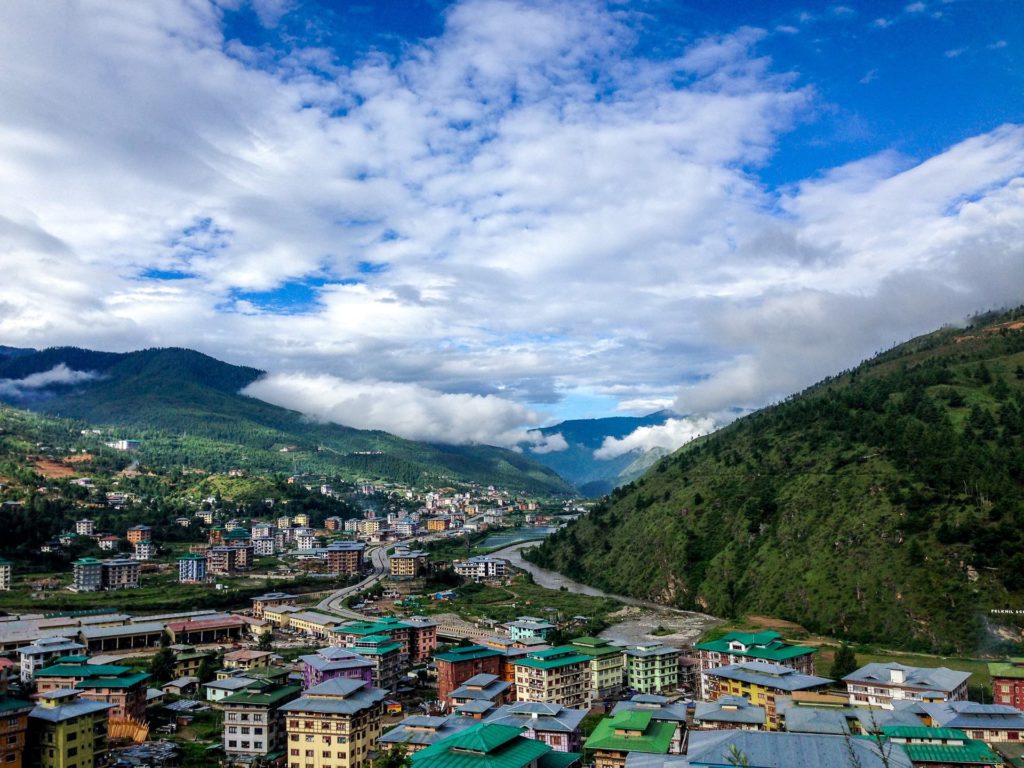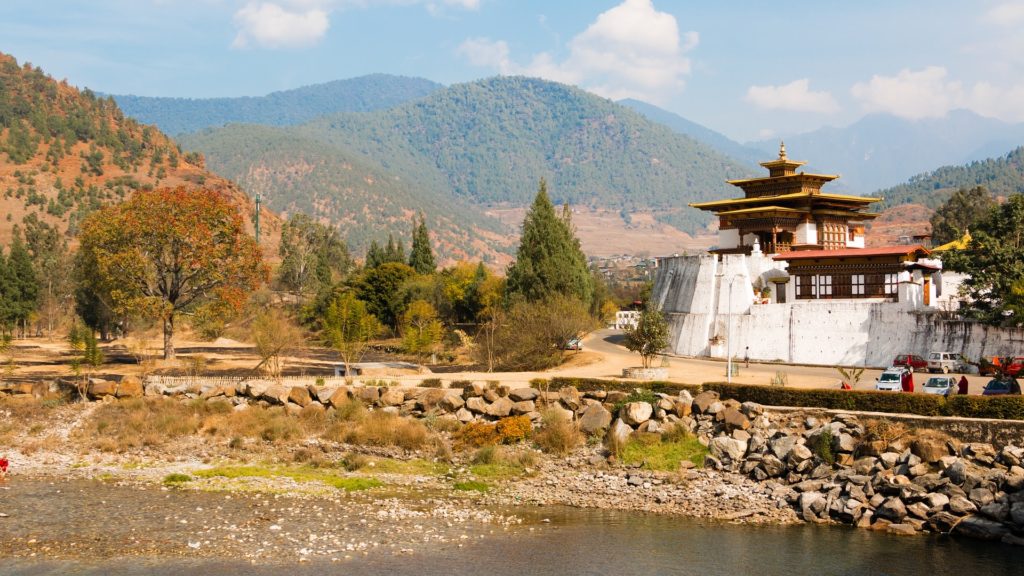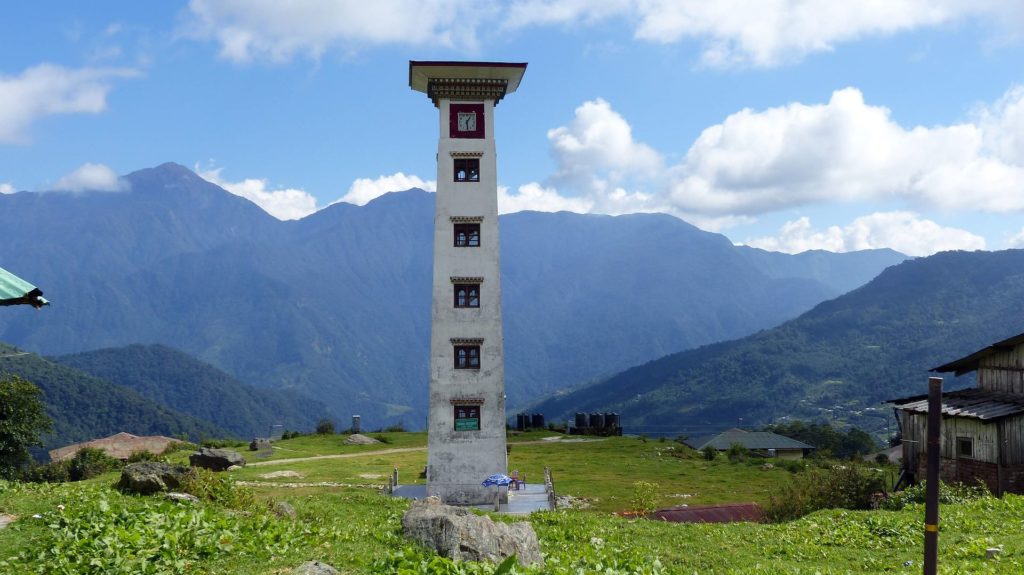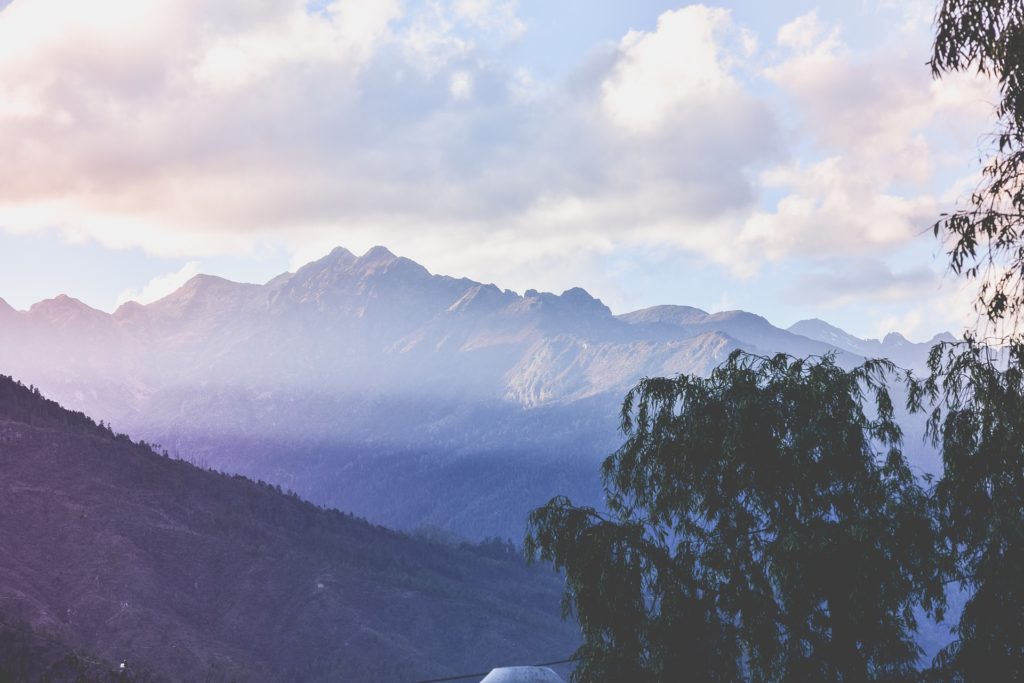Backpacking in Bhutan
Bhutan – a backpacker country? No, not really. Backpacking in Bhutan always means being with a tour operator and normally travelling in a group. The cost of travelling to Bhutan is also high – there is a tourism tax of 250 US dollars a day. Nevertheless: Bhutan belongs on every bucket list! Not only can you find here in Drukyul, the land of the dragon people, as Bhutan is called by the locals, much of the original culture of the country, which is actively protected by the state – you also get to know the only country in the world whose highest state economic goal is happiness! That alone should be worth a trip…
History of Bhutan
Bhutan was probably first settled around 2000 B.C., but historical evidence only comes from the time when the first Tibetan monks came to Bhutan – in the 9th century. At that time Buddhism became the state religion, which is still the case today. Much of the early history of this wonderful country is therefore in the dark.
Throughout its millennia of history, Bhutan has successfully defended itself against foreign rule. In the almost 100-year conflict with the East India Company, Bhutan retained its autonomy at least in part. After the capture of Assam, Great Britain also occupied parts of Bhutanese territory. The British supported the overthrow of the ruler of that time and appointed a king who was worthy of them.
With his assumption of power the first reforms began in the country. Bhutan remained independent in many ways, but was officially a British protectorate. Since 1968, Bhutan has officially been a constitutional monarchy. Political parties have also been allowed since 2007. King Jigme Khesar Namgyel, who has been in office since 2006, was the main driving force behind the gradual move towards more democratic structures.
Bhutan’s economy
The capital of Bhutan is Thimphu, the currency of the country of the Ngultrum (BTN). The Indian rupee is also a valid currency. Agriculture and forestry are the main pillars of the Bhutanese economy; more than 60% of the population live from agriculture. There are strong trade relations with India; there has been a friendship treaty with the southern neighbouring country since 1949. This treaty was renewed in 2007 and strengthens Bhutan’s autonomy and state sovereignty.
In addition to agriculture, hydroelectric energy and tourism are other important components of Bhutan’s economy. As already mentioned, tourism pays particular attention to sustainability in order to protect the country’s environment and culture. The many restrictions for travellers to Bhutan result from this endeavour.
What is special about Bhutan’s economy, however, is not its structure, but its destination. Unlike most other countries in the world, GDP in Bhutan is not the main indicator of the country’s prosperity – and GDP growth is not a declared economic policy goal. Rather, it is a matter of Gross National Happiness. What this means is that the prosperity of a country must not be measured solely in terms of the flow of money, but must be geared to the well-being of the population.
As a result, social reforms, environmental protection, health and education play a major role in Bhutan’s politics. The term “Gross National Happiness” goes back to a spontaneous statement of the Bhutanese king in the 1980s, when he answered the question about the level of Bhutan’s GDP by saying that “Gross National Happiness” was far more important.
Nevertheless, this concept of an alternative orientation in the economic goal has also found approval in the West. Since the 2000s, economists who advocate other forms of economy have increasingly been researching Gross National Happiness and attempting to establish it as a theoretical concept.
Culture in Bhutan
The population density in Bhutan is quite low with 17 inhabitants. Due to the topography of Bhutan, the settlements are unevenly distributed. Most Bhutanese live along the valleys. The capital Thimphu is not a large agglomeration and was founded in 1960; today 60,000 people live here.
Ethnic composition
Despite its small geographical size, Bhutan is ethnically diverse. There are mainly three main groups. The actual “natives” of Bhutan are the shops. They are ethnically related to ethnic groups in Burma and northern India – they live predominantly in the east of the country. The Ngalops originally immigrated from neighbouring Tibet and are closely related to the Tibetans.
Last but not least there are the Lhotsampas. They originally immigrated from Nepal. Originally Bhutan was a purely Buddhist country. This is what the government is trying to maintain. De facto there are – also by relatively recent immigration from Nepal – in the south of the country more Hindus than Buddhists. Also the language of Bhutan is not uniform. The official language is the Dzongkha, but the different ethnic groups speak their own languages. The Dzongkha is a compulsory subject for all students, but is taught in English.
Cultural change
The great peculiarity – and thus also the great experience for you as travellers – is that modernization in Bhutan is very controlled and that the state attaches importance to preventing too much foreign influence, mass tourism and radical modernization, which would mean the loss of cultural traditions. Some may take a critical view of this.
But anyone who has ever been to Nepal and knows how much has been destroyed there by mass tourism by backpackers, anyone who is aware of the misery that often results from the unconditional desire for profit and economic growth – must at least keep Bhutan on good terms, that the country is honestly striving with its course to take a better, alternative path. Even if it is certainly not perfect either.
Because of course it doesn’t work that well. In the meantime, Bhutan also has mobile phones, Internet and television – something that was unthinkable 20 years ago. Western clothing is also gaining ground, at least in the cities. With the opening comes the change. Young people are now playing video games, enjoying themselves in pubs and singing karaoke, just like everywhere else in the world. Alcohol and tobacco are also commonplace today.
Of course: If you look away from the cities, you will still find traditional rural life, even though many people there now use a mobile phone. Even the rich Buddhist heritage can still be seen everywhere in Bhutan. But who wants to experience this originality, should hurry: How long the progress remains controlled – or controllable – is very much the question.
If you want to experience Bhutan from its traditional side, you should consider travelling to a Tsechu, a religious monastic festival. These festivals take place in the Dzongs (monastery fortresses). Here you can experience the beautiful Bhutanese masks in action: The monks rehearse the dances, which are supposed to inspire the visitors to the Dharma, for months in advance. Attending such a festival is a unique event that you should not miss. However, you should check this with your tour operator in advance; he can also tell you whether festivals will take place during your trip and whether he can organise a visit for you.
Backpacker Budget in Bhutan
As far as the travel budget is concerned, there is good and bad news about backpacking in Bhutan.
The good news: Thanks to the tourist tax, the budget is actually fixed, except for pocket money for souvenirs and tips for the guides, you don’t have to think about anything else and can’t sit on the dry land or miscalculate.
The bad news: The tourist tax amounts to 200 US$ out of season and 250 US$ in season. In addition there are surcharges if you want to travel with less than 3 people. Included are tour guide, transport, entrance fee, overnight stay, full board.
When you enter Bhutan, you book a fixed tour with a licensed tour operator. The price for the tour will then be the daily fee to be paid. Assuming you book a 10-day tour through Bhutan in a larger group outside the high season, you pay 2000 US$. So actually quite simple – but not very cheap either.
Usually about 200€ as pocket money will be enough for the whole trip.
Small tip: Book a licensed tour operator in any case! Only this guarantees that you can really enter the country afterwards!
Rental car in Bhutan
You can’t rent a car in Bhutan – you get a driver and a guide to take you everywhere. All this is already included in the tourist tax.
Public transport in Bhutan
Public transport is also irrelevant for you, as you are only allowed to travel with your guides, who chauffeur you in private cars.
Backpacker Route in Bhutan
The short trips you can book with licensed tour operators are usually between 5 and 7 days long. Longer tours rarely last more than 10 days, although you can of course ask the provider of your choice for longer tours, for example if you want to do trekking. Guides and tours are also available for this. Generally, the tours are cheaper if you travel with three or more people.
Route 1: Bhutan for those in a hurry (5-7 days)
- 2 days Thimphu – Dechencholing Palace, National Library, Museum of Traditional Textile Art,
- 1 day Punakha – Punakha-Dzong
- 1 day Paro – many old monasteries and temples
- 2 day Haa Valley – Chele La Pass, Haa Valley
- 1 day Thimphu – Motithang Takin Reserve, weekly market (weekend only)
Route 2: Bhutan intensive (approx. 10 days)
- 2 days Thimphu – Dechencholing Palace, National Library, Museum of Traditional Textile Art,
- 1 day Punakha – Punakha-Dzong
- 1 day Paro – many old monasteries, visit Kyichu Lhakhang, the oldest temple of Bhutan
- 2 days Bumthang – visit of the Tamshing Goemba monastery (hike)
- 1 day Gangtey – Crane watching
- 2 days Haa Valley – Chele La Pass, Haa Valley
- 1 day Thimphu – Motithang Takin Reserve, weekly market (weekend only)
Travel times in Bhutan
The altitudes in Bhutan vary greatly, so that the climatic conditions partly differ from valley to valley. Roughly speaking, a subtropical to tropical zone in the south of the country can be distinguished from the temperate climate of central Bhutan and the high mountain climate at the highest altitudes. Bhutan is also a monsoon region; between May and September, especially in the south of the country, heavy rainfall can cause landslides and floods.
In the other half of the year, however, there is hardly any precipitation. The middle of the country is cool to moderate in winter, the summer gets a little warmer. In the high altitudes of the Himalayas the summers remain rather cool, the winters are cold. Only in the subtropical south it gets very warm in the summer, the winters are also pleasant with temperatures around 17°C.
Accordingly, the best time to travel depends on where you want to go. In general, the high season is from March to May and September to November. As already mentioned: In these months the tourist fee is 250 $ per day, in all other months 200 $. So it may be worth switching to February or December, depending on what you have in mind.
Backpacker Trips & Tips in Bhutan
One thing must be clear to you: A trip to Bhutan is not really a backpacker trip – the budget you need is enormous. In addition, there is no way to really explore the country on your own. Although you can book individual packages instead of a group tour, you will always be accompanied by a guide and a driver. Therefore, Bhutan is not really a backpacker destination and also not a destination for individual trips in general.
Nevertheless, a visit to this unique country is definitely worthwhile. The policy of gross national happiness and the strong state control of the opening and economic development of the country make it possible that traditional ways of life are still actively cultivated in Bhutan. Environmental protection is given high priority, so that you as a visitor can enjoy breathtaking, largely untouched landscapes.
Even if in the West many negative things are written about the politics of the state of Bhutan: The strong restrictions of tourism and also certain economic developments have many positive effects. The destruction of nature by excessive trekking, as we know it from Nepal, is prevented so efficiently.
For your trip you should find out exactly which aspects of the country you are particularly interested in. If your budget is rather small, you may not be able to afford a 17-day trip across the country – and even then you will of course have to make a choice. There is really a lot to see!
Below are some of the highlights and insider tips you should definitely consider for your backpacking in Bhutan.
Backpacker Highlights in Bhutan
In der Regel erreichen Sie Bhutan über den Paro Capital Airport, etwa eine Stunde westlich von Thimphu. Der Flug selbst ist ein kleines Abenteuer: Der Flughafen ist einer der gefährlichsten der Welt und benötigt eine spezielle Landeerlaubnis – der Grund: eine schwierige Navigation durch den 5000m hohen Himalaya und ein steiler 45° Abstieg zur kurzen Start- und Landebahn. Einmal angekommen, wollen Sie vielleicht nicht mehr weg, weil Sie dieses Abenteuer nicht noch einmal erleben wollen, aber sicherlich auch, weil Bhutan ein Land ist, das in seiner Natur und Kultur einzigartig ist.
Natürlich ist eine Erkundung der Hauptstadt Thimphu Teil Ihrer Reise. Einer der Höhepunkte der bhutanischen Hauptstadt ist der Dechencholing-Palast, nur wenige Kilometer außerhalb der Stadt. Erbaut in den frühen 1950er Jahren, ist dieser Palast das Hauptquartier des bhutanischen Königs. Visuell wirkt es jedoch nicht so jung, wie es tatsächlich ist. Der Grund: Wie alle Gebäude in Bhutan ist es im traditionellen Stil gebaut. Der traditionelle Baustil ist bisher für alle Häuser des Landes gesetzlich vorgeschrieben.
Ein weiteres Highlight ist ein Besuch der Kleinstadt Punakha. Dort sehen Sie den Punakha Dzong, eine Klosterfestung. Diese Art von Festung – Dzong – findet man fast ausschließlich in Bhutan und Tibet. Eine weitere Besonderheit dieses Dzong ist, dass er in einem Tal liegt und nicht typisch für eine Festung auf einem Hügel. Es liegt am Zusammenfluss der großen bhutanischen Flüsse Mo Chu (Mutter) und Pho Chu (Vater). Der Dzong in Punakha gilt als der schönste der Flüsse Bhutans. Es wurde im 17. Jahrhundert erbaut und ist bis heute die Winterresidenz der Dratshang Lhentshog (Kommission für monastische Angelegenheiten) des bhutanischen Staates.
Die Punakha-Region ist mit 1400 m relativ niedrig und daher sehr fruchtbar und subtropisch feucht. Diese günstigen klimatischen Bedingungen machen das Gebiet zu einem der wichtigsten Anbaugebiete für Reis, Kartoffeln und anderes Gemüse in Bhutan.
Ein absolutes Muss für eine Reise nach Bhutan ist die Fahrt über den Chele La Pass. Die höchste Straße Bhutans schlängelt sich bis zum Pass auf 3988 m Höhe und bietet atemberaubende Ausblicke auf wilde Rhododendren, Kiefern und bei gutem Wetter den zweithöchsten Gipfel Bhutans, den Mount Jomolhari.
Backpacker Insider-Tipps in Bhutan
Wenn Sie bereits über den Chele La Pass fahren, ist es sinnvoll, weiter ins Haa-Tal zu fahren, das erst seit 2002 für ausländische Besucher geöffnet ist. Dieses Tal ist daher touristisch nicht sehr erschlossen und nach wie vor ein echter Geheimtipp. Hier lernt man Bhutan wirklich von seiner ursprünglichen Seite kennen.
Kyichu Lhakhang in Paro ist der älteste Tempel Bhutans; er wurde im 7. Jahrhundert vom tibetischen König Songtsen Gampo erbaut – laut Legende zusammen mit 107 anderen Tempeln in einer einzigen Nacht. Ob Sie dieser Geschichte glauben oder nicht, der Tempel ist einen Besuch wert, ebenso wie das nahe gelegene kleine Museum, das Dilgo Khyentse Rinpoche gewidmet ist.
Wenn Sie zwischen November und März reisen, sollten Sie unbedingt das Gantey Valley besuchen. Die eleganten Schwarzhalskräne, die ihre Sommer in Tibet verbringen, verbringen dort den Winter. Aber auch in den anderen Jahreszeiten können Sie hier viele einheimische Tierarten beobachten, darunter Yaks, Muntjaks oder Pferdewild (Sambars).
Backpacker Accommodation in Bhutan
There are many different types of accommodation in Bhutan that you can choose from when booking your tour. There are, in the larger towns, very comfortable 5* hotels, many 3* hotels, but also the possibility of a homestay or farmstay, especially in the more remote corners of your route.
Your tour operator will book the hotels and homestays for you. Basically all accommodations are state-licensed. There is no individual camping, couchsurfing and the like in Bhutan.
Many travellers choose the most comfortable option, as the accommodation is included in the tourist tax. In this respect, there is – from a purely economic point of view – no reason to exchange a comfortable bed in a 5*-house for a bed dump on a farm without running water.
For the experience, however, this can make a lot of sense. Because with a homestay and a farmstay, you come into much more contact with the local population and get to know their daily lives. And that’s why you’ve come all the way here, isn’t it?
Food & Drinks in Bhutan
Like the other cuisines of South Asia, rice is the most important staple food of Bhutanese cuisine. In many hotels and restaurants Indian food is offered, but mostly it is no problem to try the local cuisine. In case of doubt, you should talk to your guide and ask him to take you to places where you can eat Bhutanese cuisine. It’s worth it!
As a general rule in Bhutan, tap water is not suitable for drinking! Therefore, it is not safe to eat salads, fruit and vegetables that could have been washed with tap water. So always stick to boiled and peeled food.
Food in Bhutan
The national dish of Bhutan is Ema-datsi, a mixture of chilli and cheese. Datsi is a kind of cottage cheese. Variants of this dish are Kewa-datsi, where chili and cheese are joined by potatoes, and Shamu-datsi, the same with mushrooms. The food is very tasty, especially when eaten with the red rice popular in Bhutan – but also hellishly hot!
The Bumthang region is home to many buckwheat dishes, including buckwheat pancakes, which can also be eaten with ema-datsi instead of rice. Momos (dumplings) are also very popular. Popular in Bhutan are fillings with cheese, cabbage, onions and sometimes green papaya.
Drinks in Bhutan
Bhutan is, who wanted to surprise this, a tea culture. It is drunk either as cha, i.e. with milk, sugar and often spices, or with butter. This form of tea is called Suja.
Coffee drinkers in Bhutan have to be prepared for a time full of privations. Although there is coffee, the drink has hardly any cultural significance. Those who order a coffee usually receive an instant infusion, optionally with or without milk.
As an alcoholic drink, a rice or corn schnapps is popular with the rural population of the macaw. On Tuesdays there is prohibition throughout Bhutan, alcohol may not be sold.
Backpacker Visa and Vaccinations in Bhutan
For the entry to Bhutan a visa is necessary for German citizens, which is booked over the tour operator. The entry fee is 40 US$, which is due upon entry.
Booking a tour with a licensed (!) tour operator is mandatory. Licensed Tour Operators can be found on Bhutan’s official tourism website. A tourist fee of US$200 or US$250 is due depending on the season. If you travel alone or in pairs, there will be a surcharge. The tourism fee is the same as the cost charged by the tour operator. The tourism fee includes all costs for your trip except for souvenirs you may wish to purchase and tips for your guide.
According to the entry regulations of the German Foreign Office, the following documents are accepted as travel documents:
- Passport: Yes
- Provisional passport: Yes
- Identity card: No
- Temporary identity card: No
- Child Passport: Yes
Your travel document must be valid for at least 6 months when you enter the country.
You should also check directly with the German Foreign Office for the latest details on entry requirements before your trip.
Medical Information & Vaccinations for Bhutan
There are no prescribed vaccinations for Bhutan – all standard vaccinations according to the Robert Koch Institute are generally recommended. In addition, a hepatitis A and typhoid vaccination is recommended, as well as hepatitis B, Japanese encephalitis (JE) and rabies for long-term stays. JE is mainly transmitted by mosquitoes – there is a danger especially in southern Bhutan.
At altitudes below 1700 m there is also a risk of malaria. The majority of malaria cases are of the type Malaria tropica, the dangerous form. For this reason, comprehensive mosquito protection is urgently needed. Taking chemical malaria prophylaxis is not recommended. There are some resistances to chloroquine.
Another danger comes from altitude sickness, which can be fatal in the worst case. It is caused by the low oxygen content of the air in alpine heights. It is therefore essential to slowly get used to the mountain air during ascents, trekking and even a mere excursion in the car and to turn around immediately if difficulties arise. For high altitudes, additional oxygen must be carried along.







